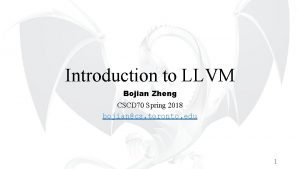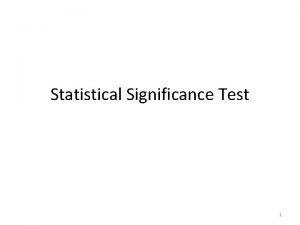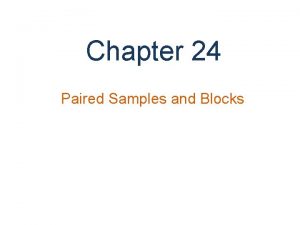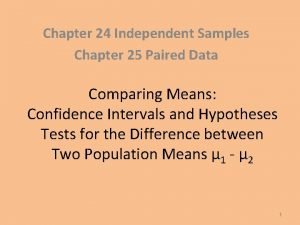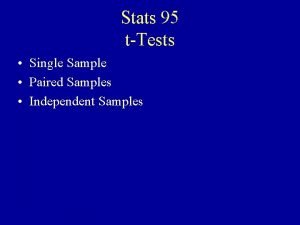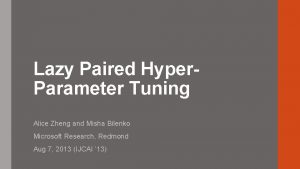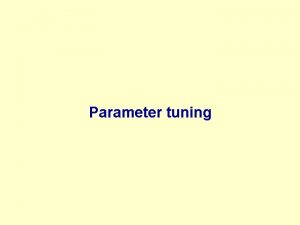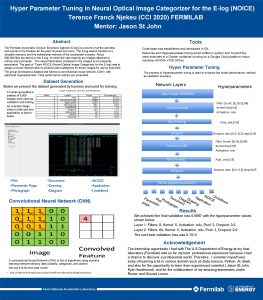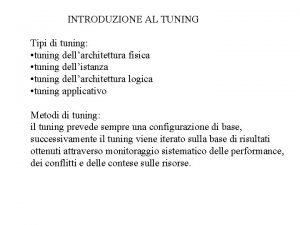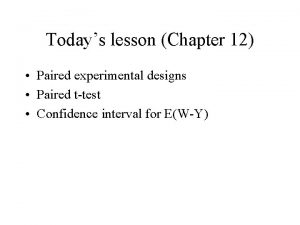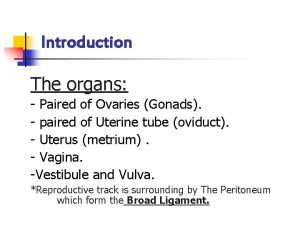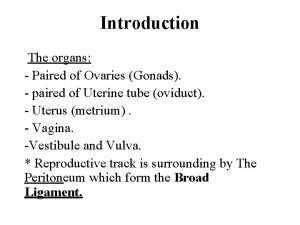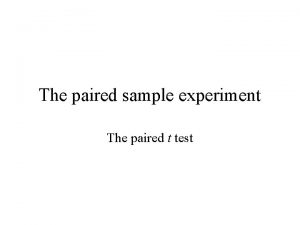Lazy Paired Hyper Parameter Tuning Alice Zheng and





























- Slides: 29

Lazy Paired Hyper. Parameter Tuning Alice Zheng and Misha Bilenko Microsoft Research, Redmond Aug 7, 2013 (IJCAI ’ 13)

Dirty secret of machine learning: Hyper-parameters • Hyper-parameters: settings of a learning algorithm Tree ensembles (boosting, random forest): #trees, #leaves, learning rate, … Linear models (perceptron, SVM): regularization, learning rate, … Neural networks: #hidden units, #layers, learning rate, momentum, … • Hyper-parameters can make a difference in learned model accuracy Example: AUC of boosted trees on Census dataset (income prediction)

Hyper-parameter auto-tuning Hyper. Parameter Tuner Training Data Learner Validation Data Validator

Hyper-parameter auto-tuning Hyper. Parameter Tuner Training Data Learner Validation Data Validator

Hyper-parameter auto-tuning Hyper. Parameter Tuner Training Data Finite, noisy samples Learner Validation Data Stochastic estimate Validator

Dealing with noise Hyper. Parameter Tuner Cross-validation or boostrap Training Data Noisy Learner Validation Data Validator

Black-box tuning Hyper. Parameter Tuner Training Data Learner (Noisy) Black Box Validation Data Validator

Q: How to EFFICIENTLY tune a STOCHASTIC black box? • Is full cross-validation required for every hyper-parameter candidate setting?

Prior approaches • Illustration of Hoeffding Racing (source: Maron & Moore, 1994)

Prior approaches Bandit algorithms for online learning • UCB 1: Evaluate the candidate with the highest upper bound on reward Based on the Hoeffding bound (with time-varying threshold) • EXP 3: Maintain a soft-max distribution of cumulative reward Randomly select a candidate to evaluate based on this distribution

A better approach •

Pairwise unmatched T-test

Pairwise matched T-test

Advantage of matched tests •

Lazy evaluations • Idea 2: Only perform as many evaluations as is needed to tell apart a pair of configurations • Perform power analysis on the T-test

What is power analysis? Predicted as True Predicted as False True Positives False Negatives False Positives True Negatives Dominant configuration predicted as tied Tied configurations, one is falsely predicted dominant • Hypothesis testing: Guarantees a false positive rate—good configurations won’t be falsely eliminated • Power analysis: For a given false negative tolerance, how many evaluations do we need in order to declare that one configuration dominates another?

Power analysis of T-test •

Algorithm La. PPT Given finite number of hyper-parameter configurations • Start with a few initial evaluations • Repeat until a single candidate remains or evaluation budget is exhausted Perform pairwise t-test among current candidates If a test returns “not equal” remove dominated candidate If a test returns “probably equal” estimate how many additional evaluations are needed to establish dominance (power analysis) Perform additional evaluations for leading candidates

Experiment 1: Bernoulli candidates •

Experiment 1: Results Best to worst: • La. PPT, EXP 3 • Hoeffding racing • UCB • Random B E T T E R

Experiment 2: Real learners • Learner 1: Gradient boosted decision trees Learning rate for gradient boosting Number of trees Maximum number of leaves per tree Minimum number of instances for a split • Learner 2: Logistic regression L 1 penalty L 2 penalty • Randomly sample 100 configurations, evaluate each up to 50 CV folds

Experiment 2: UCI datasets Dataset Task Performance Metric Adult Census Binary classification AUC Housing Regression L 1 error Waveform Multiclassification Cross-entropy

Experiment 2: Tree learner results • Best to worst: La. PPT, {UCB, Hoeffding}, EXP 3, Random • La. PPT quickly narrows down to only 1 candidate, Hoeffding is very slow to eliminate anything • Similar results similar for logistic regression

Why is La. PPT so much better? • Distribution of real learning algorithm performance is VERY different from Bernoulli Confuses some bandit algorithms

Other advantages • More efficient tests Hoeffding racing uses the Hoeffding/Bernstein bound Very loose tail probability bound of a single random variable Pairwise statistical tests are more efficient Requires fewer evaluations to obtain an answer • Lazy evaluations La. PPT performs only the necessary evaluations

Experiment 3: Continuous hyper-parameters • When the hyper-parameters are real-valued, there are infinitely many candidates Hoeffding racing and classic bandit algorithms no longer apply • La. PPT can be combined with a directed search method • Nelder-Mead: most popular gradient-free search method Uses a simplex of candidate points to compute a search direction Only requires pairwise comparisons—good fit for La. PPT • Experiment 3: Apply NM+La. PPT on Adult Census dataset

Experiment 3: Optimization quality results NM-La. PPT finds the same optima as normal NM, but using much fewer evaluations

Experiment 3: Efficiency results Number of evaluations and run time at various false negative rates

Conclusions • Hyper-parameter tuning = black-box optimization • The machine learning black box produces noisy output, and one must make repeated evaluations at each proposed configuration • We can minimize the number of evaluations Use matched pairwise statistical tests Perform additional evaluations lazily (determined by power analysis) • Much more efficient than previous approaches on finite space • Applicable to continuous space when combined with Nelder-Mead
 What was zheng he looking for
What was zheng he looking for Jianmin zheng
Jianmin zheng Dr kirti johal
Dr kirti johal The map shows that on his voyages, zheng he explored *
The map shows that on his voyages, zheng he explored * Should we celebrate the voyages of zheng he essay
Should we celebrate the voyages of zheng he essay Indicates ambition, cool-headedness, and fierceness
Indicates ambition, cool-headedness, and fierceness Bojian zheng
Bojian zheng Zuyin zheng
Zuyin zheng Zheng
Zheng Task 1 unit 4
Task 1 unit 4 Shuran zheng
Shuran zheng Cindy zheng
Cindy zheng Whyjay zheng
Whyjay zheng Patrick zheng
Patrick zheng Zheng jiang history
Zheng jiang history 2 sample t test formula
2 sample t test formula Unpaired vs paired t test
Unpaired vs paired t test Chapter 24 paired samples and blocks
Chapter 24 paired samples and blocks Chapter 25 paired samples and blocks
Chapter 25 paired samples and blocks Pared t test
Pared t test Chapter 25 paired samples and blocks
Chapter 25 paired samples and blocks Eager learning
Eager learning Skill 12 agreement after expressions of quantity
Skill 12 agreement after expressions of quantity Why was achilles almost-undefeatable?
Why was achilles almost-undefeatable? Quadrat
Quadrat How to calculate sample size in research
How to calculate sample size in research Soft paired cone shaped organs
Soft paired cone shaped organs Checklist method
Checklist method Paired comparison method of performance appraisal
Paired comparison method of performance appraisal Use parallel structure with paired conjunctions
Use parallel structure with paired conjunctions






